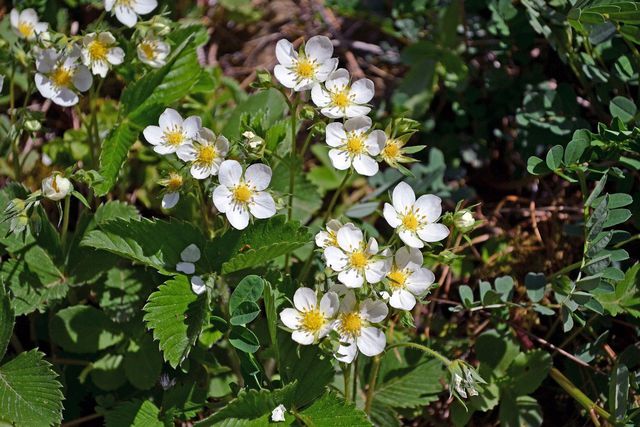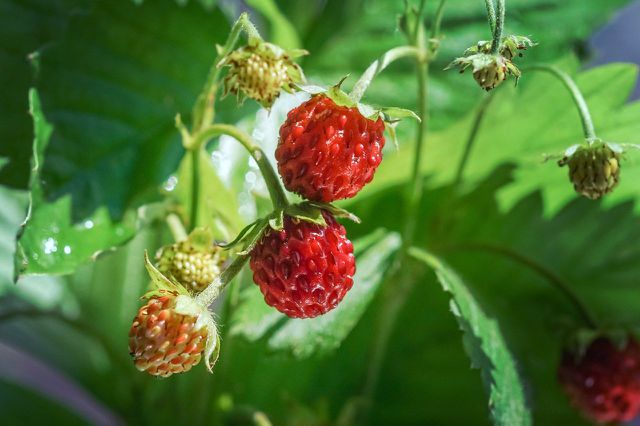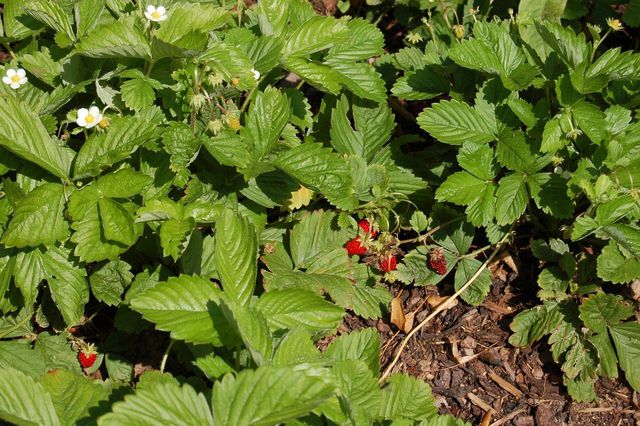
Wild strawberries taste fruity-sweet and are very easy to grow in your own garden. We give you tips on how to do it and what you can do with the wild strawberries.
Wild strawberries grow in deciduous and coniferous forests and provide food for numerous animals. However, you can also easily plant the plant in your own garden.
Wild strawberries bear fruit throughout the summer, so you can harvest them again and again. The fruits are quite small and only grow to about one centimeter in size. They are ripe when they are completely red and easy to pick. There are also white and yellow varieties.
The leaves of the wild strawberry have an intense green color and are divided into three parts. The flowers shine white from April to June with yellow stamens in the center. They are rich in nectar and pollen and attract bees and other insects – wild strawberries are thus insect and bee friendly.
The plant grows perennially and easily forms runners. So you may well welcome a few more wild strawberry plants in the garden next year, which can even cover the entire ground as ground cover.
By the way, biologically speaking, strawberries are not considered fruits, but rather nuts (more precisely, aggregate nuts). See our article Why the strawberry is a nut.
Contents
How to plant wild strawberries

What do you need to consider when planting wild strawberries?
- Location: It is best to choose a semi-sunny location for wild strawberries, i.e. a bright spot without direct sunlight. Sunny locations are also okay – but here you need to water sufficiently. You can also plant the strawberries on shrubs or under trees, for example. Wild strawberries also do well in window boxes on balconies.
- Soil: The soil should be nutrient-rich and well-drained. Use humus and sand to loosen the soil. Make sure the soil is peat-free to protect the bogs.
- Seedlings: The easiest way to do this is to buy young plants from a garden center or hardware store in the spring. If you wish, you can also sow the wild strawberry yourself in seed trays. You can then plant out the cuttings in July. Note that newly grown wild strawberries usually do not bear fruit until the following year.
- Time: You can sow wild strawberries from the end of February to around mid-March. Young plants are best planted in July. Since wild strawberries are quite hardy, they can also cope with other times such as April, May or August.
How do you plant the wild strawberries?
- In the garden: Dig holes about twice the size of the plant ball. Keep a planting distance of 20 centimeters. Water everything sufficiently. If you want, you can put the wild strawberry seedlings in some water while you dig the holes. This way you will better prepare the young plant for transplanting.
- In the balcony box: Here you should create a drainage. This can be done by placing stones at the bottom of the box or by loosening the soil with sand. You can read more about this in our article Waterlogging: These tricks will help you avoid it. The box should be large enough to give the plants room to spread out and grow. Apart from that, the same should be observed on the balcony as in the garden.
How to care for wild strawberries

- Watering: The wild strawberry likes it moist. So adjust the watering rhythm and the amount of water to the weather. On hot days, you can often water in the morning and evening. Do not water in the midday sun. Avoid waterlogging at all costs, as it can lead to root rot. The soil should dry out in the meantime and only be lightly moistened.
- Fertilizing: Fertilizing is usually not necessary. If you do want to fertilize, do so before flowering and in moderate amounts. Use natural and organic fertilizers such as compost. If you wish, you can mulch the soil as soon as the first fruits grow.
- Propagation: The wild strawberry usually propagates very well by itself. If you want to help it along, you can press the long cuttings into a hollow in the soil.
- Diseases and pests: Wild strawberries can be attacked by slugs and insects such as the strawberry blossom pest. Indications of it are withered and falling flower buds. Infestation is most common when the plant grows near a forest. A common disease is strawberry powdery mildew. You can read about what home remedies help against it in our article Fighting Powdery Mildew.
- Wintering: Forest berries get through the winter without any problems. You can support them with a few simple steps. Please refer to our article “Wintering strawberries: the ideal winter quarters”. For example, cut them back in the fall and fertilize them again. How you can use the leaves instead of throwing them away, you will learn in the next paragraph.
How can you use wild strawberries?

The wild strawberry is considered a medicinal plant. Thus, the fruits are said to help with heart problems, gout or rheumatism and have positive effects on bile and liver.
- For snacking: The small fruits of the wild strawberry are wonderful as a snack between meals. Freshly picked in your own garden, you can eat them immediately.
- To refine: Mix freshly picked wild strawberries in your yogurt (preferably organic natural yogurt, homemade yogurt or vegan yogurt). In drinks such as water, lemonade or aperitifs, the small berries provide a fruity note and also serve as decoration.
- Jam: For a fruity-sweet jam, cook wild strawberries together with lemon juice and preserving sugar. Read our recipe jam cooking: Basic recipe to make yourself. However, you need quite a few strawberries, so picking takes a long time and you can only prepare a small amount.
The leaves of the wild strawberry are also said to have healing powers. They are said to have a soothing effect on the skin and purify the blood.
- Tea: You can prepare an aromatic tea from the leaves of the wild strawberry. Pick a few leaves and let them dry on a kitchen towel in the air (not in the sun). Crush them with your fingers or a knife. Now use a hair strainer or tea infuser and steep everything in hot water for about ten minutes. For a large cup (250 ml) you need about two teaspoons of dried strawberry leaves. If you like, you can mix the leaves with other tea herbs or fruit teas.
- Facial tonic: If you let the dried leaves steep longer, you can use the decoction cold as a facial tonic. You can also use the tincture for rashes and apply it with a clean cloth.

